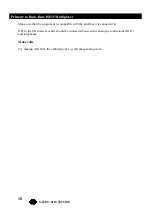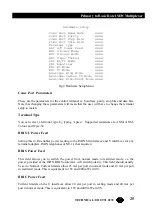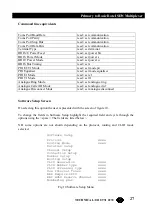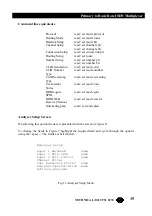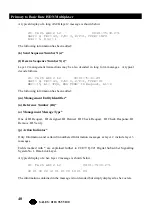
32
Primary to Basic Rate ISDN Multiplexer
SALES: 0118 965 5100
Number Set-up (National ISDN protocol)
This option brings up menus that allow numbers to be assigned to the basic rate interfaces.
Use the cursor keys and <ENTER> to select the number to be changed. Use <ENTER> to
change the number. Use <BACKSPACE> to delete a number.
Two numbers can be set up for each basic rate interface, one number can be set up for each
analogue interface and one number can be set up for PRI 2.
The numbers used for ETSI protocol and National ISDN protocol are stored separately. The
correct protocol should be selected before changing the numbers.
Some examples for numbers are given in an appendix.
The match numbers in Number Setup have 2 purposes :
Choosing the port to send a call to.
Two match numbers (a) and (b) can be set up for each BRI port. They are for 2 separate TA's
or for 1 TA that uses 2 SPID's.
The match numbers should be chosen from the directory numbers for the PRI line. The match
number set up for the BRI TA acts as the directory number for the BRI TA. The Service
Profile Identifier (SPID) for a BRI TA is equal to the match number with 0101 added. This is
the generic SPID format from Bellcore National ISDN 97.
NB: The match numbers should all be different.
Incoming calls have the Called Party Number in the SETUP message compared with the
match numbers. The call is routed to the BRI TA with a matching match number. If there is
no matching match number, the call is routed to a free b channel on the PRI port. If this also
fails, the call is rejected.
NB: the number entered for PRI 2 has no effect on the routing of the call.
(ii) Calling Line Identification
This applies if CLID Generation is set to “Yes”. The Primary to Basic Rate ISDN
Multiplexer adds or changes the Calling Party Number in SETUP messages to the network.
The menu includes a CLID number for PRI 2 and match numbers for the BRI's. The match
numbers also act as CLID numbers.
If there is a Calling Party Number in the SETUP message from the terminal and it matches
one the CLID numbers for that TA then it is passed through unchanged. Otherwise, the CLID
number for that TA is used.

